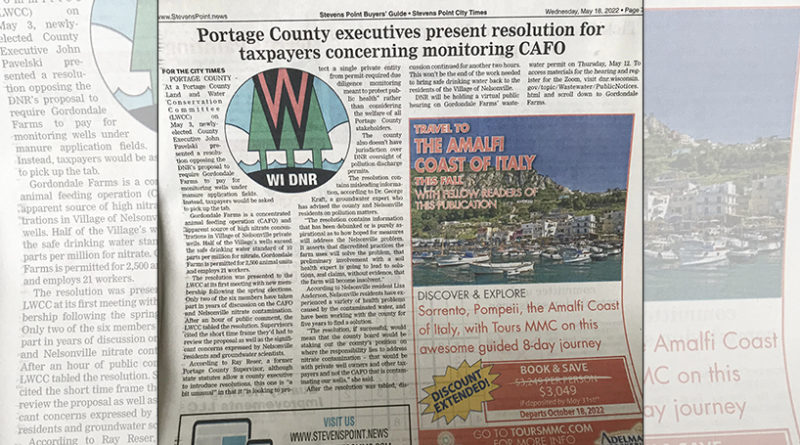Editor’s Note: No, the DNR did not publish this May press release
By Brandi Makuski
It’s widely believed in the news industry that publicity expert Ivy Lee was the first to send out a news release.
It was Oct. 28, 1906, and more than 50 people had just died in an Atlantic City train wreck. Lee was the PR man for Pennsylvania Railroad. He detailed the events so well that the New York Times published his news release verbatim—a rare occurrence in the news industry.
Since then, the “press release,” an announcement of an upcoming event, was born, and is often incorrectly used interchangeably with the term “news release.”
For the sake of expediency, a “press release” is something sent prior to an event that essentially amounts to free advertising for an upcoming event. A “news release” is something sent after an event containing a summary of the event and statements from public figures or other relevant persons.
Both are a no/low-cost option for business owners, group representatives, politicians, and municipal agencies, such as police or fire departments in communicating with the press or the public.
But this option also requires a higher degree of awareness and responsibility for everyone involved, because a press/news release is third-party content and very different from a news article. It’s rare that either is published verbatim without verification of the details it contains. Anyone trained in the field of journalism labels a press release as such, but generally, pieces of a release are used to complement an original news article, not to replace it.
If the news release is published word-for-word, it should include the byline, “For the (Name of Publication)” to indicate it was written by a third party. News releases on a controversial topic should not be published without an editorial disclaimer, although these are probably more appropriate to place in the opinion section and with the author’s name.
But what happens when a news outlet doesn’t follow the industry’s long-held best practices that readers have come to rely on?
According to Pew Research Center, more than 60 percent of Facebook and Twitter users receive their news via social media, 70 percent of adults don’t read past a headline, and a whopping 47 percent of American adults believe that Facebook is a news reporting agency.
Those numbers are alarming and show the real need for ongoing public education on news literacy, and special training for those in charge of posting information to social media accounts and sending information to the press.
Those numbers also mean that publishers and editors really need to be on top of their game all the time. As the news industry continues to suffer from dwindling advertising and subscriber revenue, some news outlets take shortcuts and publish these releases without any of the aforementioned safeguards in place.
It becomes even more concerning when a news outlet pairs a news release on a controversial topic, for example, the Nelsonville CAFO, with accompanying art from the Wisconsin Department of Natural Resources. It strongly implies the news release is from the state.
The piece in question is a press release penned (ostensibly) by Amberle Schwartz, who challenged Supervisor Scott Soik in the April election for the District 19 seat on the Portage Co. Board but lost.
Shortly after the election, Schwartz announced the formation of Portage County for Clean Water. She bills the group as “a nonpartisan, non-ideological, evidence-based advocate for maintaining, enhancing, and improving Portage County’s groundwater, lakes, streams, and wetlands. Our mission is to strive for safe drinking water and healthy surface waters that sustain human health and robust fish and wildlife populations for current and future generations.”
Schwartz displays some fair writing chops, formatting each release as though it were a news story, with shorter paragraphs, data, and quotes, and encouraging residents to provide their opinions to the Wisconsin Department of Natural Resources. Provided the information is objective and accurate, these are all good things.
Sadly, it does not appear that Schwartz’s piece is being presented in the proper light. One publication ran a May 11 piece from Schwartz in a manner that makes it appear like a news release from the DNR. It’s confused more than a few residents, as our newsroom has received phone calls from readers seeking clarification on the issue, and expressing frustration with an inability to reach anyone at the Stevens Point City Times or Portage County Gazette.
Robin Falk, executive assistant to County Executive John Pavelski, on Friday said that Pavelski has also received calls from confused residents. Pavelski plans to send out a response to Schwartz’s release, which is why you haven’t seen this published yet by the Metro Wire: it’s our job to ensure the information is presented fairly.
Also in the course of our due diligence, we reached out to the DNR seeking comment. Sarah Hoye, communications director for the DNR, confirmed via email last week that “the department did not send any press releases to media relating to the article you referenced published in the Stevens Point News on May 13, 2022.”
Hoye said the last communication related to the Nelsonville CAFO that the department sent to the media was on April 12 and was one seeking public input on the proposed permit modification. The Metro Wire ran that story, on April 13, here.
The Metro Wire reached out to Kris Leonhardt, the managing editor of the Stevens Point City Times and Portage County Gazette, on Friday to ask why an unedited, unvetted press release from an advocacy group was published with a WisDNR logo—and without being identified as a commentary/call-to-action piece from an advocacy group. Leonhardt didn’t immediately respond.
It’s not the first time this company has reported inaccurate information—or reported information inaccurately and outside of journalism’s best practices. In 2018, the company published an inaccurate story about the health care center referendum that was called out by county government officials. While the story has since been pulled from the company’s website, it’s not clear if any retraction was published.
We called the company out again in April 2019 when it published inaccurate stories alleging there was “severe flooding in the Park Drive and Twin Towers Drive areas have left streets flooded, and residents worried.” Never mind that Twin Towers Dr. is in the southeast area of the Village of Plover while Park Dr. is located in the southwest section of the Town of Plover. They’re six miles apart.
It’s hard not to constantly question the state of the local news industry, particularly when one outlet so regularly and completely violates just about every ethical standard held dear by trained journalists. We hope readers are paying attention because it really does matter.


